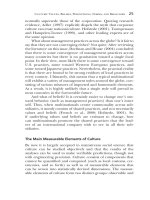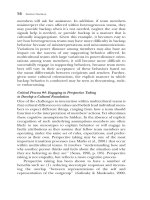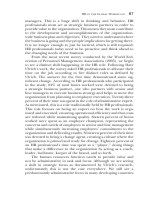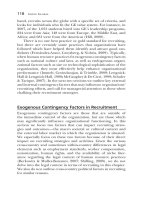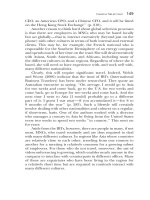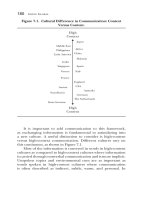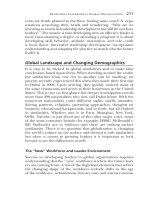Practical Applications and Recommendations for HR and OD Professionals in the Global Workplace J-B SIOP Professional Practice Series_7 potx
Bạn đang xem bản rút gọn của tài liệu. Xem và tải ngay bản đầy đủ của tài liệu tại đây (2.29 MB, 15 trang )
069-082 HBE-MCT C5 3rd 10/15/02 9:56 AM Page 82
This Page Intentionally Left Blank
Helping People Adapt
Key Topics Covered in This Chapter
•
The four stages of reaction to change: shock,
defensive retreat, acknowledgment, and
acceptance and adaptation
•
How individuals can help themselves navi-
gate change
•
How managers can help employees cope
with change
•
Alternative ways for managers to think
about change resisters
Strategies to Help Reduce Stress and Anxiety
6
083-100 HBE-MCT C6 3rd 10/15/02 9:56 AM Page 83
T
he business press and many academics like to
talk about the importance of change, and how it makes
us all better people and more satisfied and fulfilled with
our work.They extol the virtues of “thriving” on chaos and encour-
age us to “embrace” change as if it were something we just can’t get
enough of. You get the feeling that had they been around during
the thirteenth century these writers would have described the Cru-
saders’ sack of Constantinople as a “mutual learning experience” for
the Latin West and the Byzantine East.
In reality, change puts lots of people through the wringer—
particularly Theory E change that aims to quickly increase share-
holder value. Far from “thriving,” some employees don’t survive the
change program at all, let alone come out in one piece. Both unsuc-
cessful and successful change programs produce stress, and many re-
sult in the displacement of good people. Ask the thousands of
General Electric employees who lost their jobs when Jack Welch
pared down his company to a manageable set of future-facing busi-
nesses.They didn’t call him Neutron Jack for nothing.The same goes
for “Chainsaw” Al Dunlap, who lopped off great chunks of the em-
ployment ranks at Scott Paper in a major corporate makeover. Ask
the people who survived several rounds of downsizing at IBM and
Cisco Systems about “embracing” change.
In these types of changes, survivors are almost universally shell-
shocked.Their morale is poor, trust in the company is at rock bot-
tom,and employee loyalty is out the window. A good manager cannot
restore the world for these people,but he or she can help them through
083-100 HBE-MCT C6 3rd 10/15/02 9:56 AM Page 84
the turmoil,and get them back into a productive frame of mind. This
chapter explains the stress caused by workplace change and what you
can do to help people through it.
Reactions to Change:
A Sense of Loss and Anxiety
The typical employee spends at least eight hours a day doing, in
general, fairly routine tasks. Indeed, when companies talk about
their “culture,” they imply a certain measure of stability and routine.
They reinforce that stability with job descriptions that prescribe in
concrete terms what employees should do day-to-day and week-to-
week.There’s a tangible agreement that if the employee does X, and
does it well and on time, the employee will receive Y in compensa-
tion and be viewed as a company member in good standing.
There is also a psychological contract between employee and com-
pany: As long as the employee fits into work and social patterns, he or
she “belongs.”And there is a political dimension as well, demanding
that career-minded employees attend to certain written and unwrit-
ten “rules” of the game.But what happens when the contract or rules
are changed unexpectedly? Take the following case, for example:
This morning we got a memo addressed to “all staff.” It said that
year-end performance bonuses are being discontinued. Just like that—
20 percent of my salary out the window! And after all the long hours
I’ve put in during the last months
How would you suppose this person might feel? She has defi-
nitely experienced a loss. Losses caused by change programs usually
aren’t as drastic as this, however.They are more likely to be a change
in job description, or a perceived loss in turf, status, or self-meaning.
They tend to be threats to values that someone has built up, rather
than monetary losses.
Even a positive change can create anxiety for some people. For
example, a person who’s given a promotion may wonder: Can I han-
dle the job? How will my friendships with people in the department
Helping People Adapt 85
083-100 HBE-MCT C6 3rd 10/15/02 9:56 AM Page 85
be affected now that I’m their boss? Will the required travel and
longer hours create problems at home?
Those questions reflect a fear of the unknown, which often ac-
companies a loss of certainty. For most people, however, the negative
aspects of change are related to a loss of control—over their incomes
and influence, their sources of pride, and how they have grown ac-
customed to living and working.When these factors are threatened,
expect to see anxiety and anger.
Stages in Reaction to Change
Most people eventually adapt and are reconciled to change, but not
before passing through various psychological stages, which are ex-
amined here. One way to think about those stages is through the
concept of risk.According to one theory, change requires people to
perform or perceive in unfamiliar ways, which involves risks. Those
risks potentially threaten a person’s self-esteem.
1
Understandably,
people are uncomfortable with risk and tend to avoid it when they
can. When they cannot, however—as when they’re roped into a
corporate change initiative—adaptation to change tends to proceed
through predictable psychological stages. In some respects, these
stages resemble the grieving process a person experiences after the
loss of a loved one.The four stages are:
2
1. Shock.–In the shock phase, people feel threatened by antici-
pated change.They may even deny its existence:“This isn’t
happening.” They become immobilized and often shut down
in order to protect themselves. People feel unsafe, timid, and
unable to act, much less take risks. Needless to say, productivity
drops during this stage.
2.
Defensive retreat.–Eventually people caught in a change vortex
move from shock to defensive retreat.They get angry and lash out
at what has been done to them, even as they hold on to accustomed
ways of doing things.They attempt to keep a grip on the past
86 Managing Change and Transition
083-100 HBE-MCT C6 3rd 10/15/02 9:56 AM Page 86
while decrying the fact that it’s changed.This conflict likewise
precludes taking risks; the situation is perceived as too unsafe.
3.
Acknowledgment.–Eventually, most people cease denying the
fact of change, and acknowledge that they have lost something.
They mourn.The psychological dynamics of this stage include
both grief and liberation.Thus, one can feel like a pawn in a
game while also being able to view that game with some de-
gree of objectivity and psychological distance.At this point the
notion of taking risks becomes more palatable and people begin
to explore the pros and cons of the new situation. Each “risk”
that succeeds builds confidence and prepares people for more.
4.
Acceptance and adaptation.–Most people eventually internalize
the change, make any needed adaptations, and move on.They
see themselves “before and after” the change and, even if it’s a
grudging acknowledgment, they consider the change “for the
best.” In some cases, people actively advocate for what they had
previously opposed.Acceptance and adaptation means relin-
quishing the old situation, as well as the pain, confusion, and
fear experienced in the earlier stages of change.
Progress through these four stages is linear and should only be
accelerated with great care. Speeding up the process risks carrying
unfinished psychological “baggage” from one phase to the next.
Thus, if you’re the manager of people going through the four-stage
process you need to resist your natural bias toward action and exer-
cise patience.The expression “time heals all” says it well enough.
This theory about how people deal with change and eventually
accept it is somewhat simplistic.Although most people work through
the four emotional stages—some more quickly than others—some
will get stuck in defensive retreat and channel their energies into
resistance.
People get stuck for two basic and obvious reasons: first, change
is not a single event with neat and tidy beginnings and endings; and
second, people’s experiences with change vary with individual circum-
stance.Thus, frameworks like this one are far from perfect.To further
Helping People Adapt 87
083-100 HBE-MCT C6 3rd 10/15/02 9:56 AM Page 87
complicate matters, change often hits from two or more directions at
the same time. For example, a division of a large corporation is put
through a wrenching restructuring in which many people are fur-
loughed;the same division is then sold to another corporation, which
results in new leadership and new policies. Coming all at once (or in
rapid sequence), these multiple changes can severely stress or undo
the anchor points of the employees and managers who remain.Agreed-
upon ways of working, affiliations, skills, and self-concept slip away.
When anchor points such as these are removed, most people are im-
mobilized or thrown into a defense mode. In a worst-case scenario,
the individual under siege at the office is simultaneously experienc-
ing major change at home—a divorce, for example.
People who are emotionally fragile are at the greatest risk during
change initiatives.They typically have the greatest difficulty handling
feelings of loss and may choose to see themselves as victims of the
process.A perception of victimhood will always hinder an employee’s
ability to move on after change has occurred.
The Conventional Advice
Smart managers attempt to accelerate adaptation to change, and for
understandable reasons: Employees who are preoccupied with their
internal issues are not fully productive. Indeed, people in the early
stages of change are often unable to do much at all. It thus makes
good business sense to help them cope and move forward. Unfortu-
nately, such good intentions are often viewed as manipulative, con-
trolling, or autocratic. If the benefits of change are overly hyped, if
there are too many pep rallies and too many “it’s really good for you”
assurances, people will become cynical and dig in their heels.“How
can they say everything is rosy when I feel as though I’ve been
stabbed in the back?”
So, what can you do to minimize the negative aspects of change
for people in your organization? Consider the following list of con-
ventional advice for dealing with change:
88 Managing Change and Transition
083-100 HBE-MCT C6 3rd 10/15/02 9:56 AM Page 88
• Keep your cool in dealing with others.
• Do your best to handle pressure smoothly and effectively.
• Respond nondefensively when others disagree with you.
• Develop creative and innovative solutions to problems.
• Be willing to take risks and try out new ideas.
• Be willing to adjust priorities to changing conditions.
• Demonstrate enthusiasm for and commitment to long-term goals.
• Be open and candid when dealing with others.
• Participate actively in the change process.
• Make clear-cut decisions as needed.
This is good advice, but it fails to take into account psychologi-
cal needs that must be addressed. Most people are aware of the wis-
dom of taking responsibility for dealing with change themselves;
they recognize the importance of the “right attitude.” Most people,
however, do not want this shoved down their throats. Rather, they
prefer some empathy, and some understanding of what they are ex-
periencing.They are less interested in advice than in understanding
and support.
The next two sections explore ways in which people facing
change can help themselves and provide guidelines that managers
can use to help their employees (and themselves) cope with difficult
parts of the change process.
What Individuals Can Do for Themselves
The strong emotions that most of us feel at the onset of change—
anger, depression, and shock—are not useful.They neither comfort
us nor move us forward. And they are often emotional.We have ra-
tional and emotional sides of our beings, and each must be paid its
Helping People Adapt 89
083-100 HBE-MCT C6 3rd 10/15/02 9:56 AM Page 89
due. (See “Tips for Recognizing the Emotional Side.”) The secret to
success is to allow the emotional side to express itself—that is, to give
it due recognition—but to gradually pass control to the rational side.
Overcome Powerlessness
A feeling of powerlessness, or loss of control, is a major cause of
change-related distress. Someone over whom we have no control has
arbitrarily upset the routines of work, sold off the division, laid off
many of our workplace friends, or altered the compensation system.
Worse, we have no recourse.
One antidote to feeling powerless is to establish a sense of per-
sonal control in other areas of our lives. For example, taking charge
of your investment club’s monthly newsletter or designing a room
addition to your house represent ways to regain a sense of personal
control.Another antidote is to avoid taking on other efforts that sap
energy. Thus, if adapting to change is arduous, individuals should
husband their resources. This entails not only maintaining physical
well-being, but nourishing your psyche. For example:
90 Managing Change and Transition
• Remind people that anger, depression, and shock are natural
reactions to loss. People need to give themselves permission
to feel what they are feeling. Change always involves a loss of
some kind: a job, colleagues, a role, even one’s identity.That
loss must be duly acknowledged and mourned.
• Let mourning take its course.
• Be patient. Recognize that time is needed to come to grips
with a situation and move through the various stages. It can-
not be done overnight, and no single timeline works for
everyone. But don’t let people wallow in self-pity and grief.
Tips for Recognizing the Emotional Side
083-100 HBE-MCT C6 3rd 10/15/02 9:56 AM Page 90
• get enough sleep
• pay attention to diet and exercise
• take occasional breaks at the office
• relax with friends
• engage in hobbies
These are not forms of escapism, nor do they distract a person from
reality. Rather, they are practical ways of exerting control over one’s
life during a period of flux.
Inventory the Gains and Losses
Accepting strong emotions and acknowledging the importance of
patience in dealing with change are vital; but so is developing objec-
tivity about what is happening.We have choices in how we perceive
change, and we are able to develop the capacity to see benefits, not
just losses, in new situations. Coming to accept and adapt to change
is in fact a process of balancing: “What have I lost?” should be bal-
anced by “What am I gaining?” This is far different than “looking on
the bright side.” Inventorying personal losses and gains is a tangible
step that people can take in gathering the strength to move on.
Re-anchor
“Re-anchoring”is related to inventorying gains and losses.Here,the in-
dividual balances the emotional investment in essential work-related
anchor points—how work is done, affiliations, skills, self-concept in
relation to the work—with emotional investments in other areas,
such as family, friends, and civic and religious activities.Thus, when
one or more anchor points at the workplace is uprooted, the person
can remain steady by creating or strengthening anchor points else-
where. For example,if workplace change has resulted in your transfer
to a new department where you have no real friends, you could:
Helping People Adapt 91
083-100 HBE-MCT C6 3rd 10/15/02 9:56 AM Page 91
• develop new friendships in that department;
• join the department softball team; or
• solidify your friendships outside work—for example, by attend-
ing the Thursday night book club meeting you’ve skipped for
the past year.
Admittedly, inventorying and re-anchoring are difficult when a
person is in the grip of strong emotions. Perhaps the best mecha-
nism for coping with change, then, is anticipating it. No one escapes
the effects of change, in the workplace or elsewhere, but those
who recognize that its impact will be powerful, that the process of
adaptation and acceptance will take time, and that we all have other
sources of strength, are much better positioned than those who are
caught flat-footed.
How Managers Can Help Employees Cope
Many managers find that addressing straightforward, technical issues
in the change effort—such as the new department layout, or who
gets what training—is comparatively easy. But consciously or not,
they ignore the more complex and unpredictable concerns of people
being changed.The rationale may be a business one:“We don’t have
time for that; we’re here to make money.” Or it may be emotional:“I
don’t want to get involved in messy feelings; that’s not my job.”
Ignoring the human side of change, however, is shortsighted and
a symptom of ineffective management. Managers are paid to get
things done with the human and financial resources given to them—
imperfect as those resources may be. Like infantry platoon leaders in
a skirmish, they must muster all the firepower at their disposal—and
that means getting every one of their people engaged.They cannot
afford to write off people who are too afraid to move.They have to
get everyone into the fight. And that sometimes means helping them
through their fear. With that thought in mind, let’s consider what
managers can do at each of the four stages described earlier.
92 Managing Change and Transition
083-100 HBE-MCT C6 3rd 10/15/02 9:56 AM Page 92
Stage One: Shock
Good managers prepare people for change long before the shock hits.
Returning to our military example,military organizations don’t wait
until the heat of battle to deal with the shock it induces in people.
Instead, they prepare soldiers for what lies ahead through rigorous
training and simulations. As a manager, you, too, can prepare your
people for the shock of change by periodically inoculating them with
small doses of it:
• Change work processes whenever you see real opportunities
for improvement.
• Give people periodic reassignments that force them to learn
new things and deal with new situations.
• Use stretch goals to encourage flexibility and greater effort.
• Never allow anyone to get too comfortable in his or her job.
• Root out any sense of entitlement.
If you prepare people for change, they will experience less shock
when a really big shake-up hits your unit.Preparation is probably the
most important thing you can do as a change manager. Even with
good preparation, however, there’s bound to be shock, and you’ll
have to deal with the denial,“shutting down,” and timidity that char-
acterize this stage.You’ll need to apply some “first aid”:
• If people have had the anchors of their work lives yanked away,
find new ones for them to latch onto.These may be their new
roles in their new work groups.
• Provide opportunities for people to vent their feelings.
• Be a good listener, but avoid trying to sell them on the idea
that things are actually better for them—they are not yet ready
to hear this.
• Help your employees manage the stress that results from change
(see the “Managing Stress Levels” checklist in appendix A).
Helping People Adapt 93
083-100 HBE-MCT C6 3rd 10/15/02 9:56 AM Page 93
Stage Two: Defensive Retreat
People in the stage of defensive retreat get angry and lash out even as
they try to hold on to the old ways of doing things.This behavior re-
duces their productivity. Here are a couple things you can do to get
them through this stage:
• Do what you can to keep “retreaters” connected to the imme-
diate group—the strongest anchor there is. Individuals who
find themselves decoupled from their familiar social arrange-
ments are likely to be the most damaged, since the group acts
as a source of identity, safety, and support.The military, which
has enormous experience in this area, emphasizes what it calls
“small group cohesion.” It knows that soldiers will do remark-
able things as members of small, closely-knit groups (see “The
Power of Small Group Cohesion”).You should do the same by
helping people connect to others in their new circumstances.
Group activities, lunchtime meetings, or outings all help build
connections between strangers.
• Provide a verbal outlet for the grievances and the angst that
needs to be vented.When management provides opportunities
for grievances and frustrations to be aired constructively, em-
ployee bitterness and frustration may be diminished.
Stage Three: Acknowledgment
Eventually, most people stop denying the fact of change and ac-
knowledge their new situation.The psychological dynamics of this
stage include both grief for what has been lost and nascent feelings
of liberation. Though they continue to feel like pawns in a game
controlled by others, they begin to view that game with a certain
amount of distance and objectivity. Risk-taking becomes possible as
people begin to explore the pros and cons of the new situation.
You can help people in this stage in several ways:
94 Managing Change and Transition
083-100 HBE-MCT C6 3rd 10/15/02 9:56 AM Page 94
• Continue your role as a sounding board for complaints and
questions.Ask “How do you feel about this?” to get a fix on an
individual’s emotional state. But begin now to stress the bene-
fits of the new situation.
• Build further on the “anchors” and group cohesion you estab-
lished in the previous stage.
• Encourage people to try new things—to take some risks.Ask
“What could we do about this?” Each risk that succeeds will
build confidence and prepare people for the final stage.
Helping People Adapt 95
Biographer/historian William Manchester was wounded dur-
ing the bloody World War II battle to take the Japanese-held is-
land of Okinawa. Although Manchester had a “ticket home”
wound, he skipped out of the field hospital and rejoined his
unit of U.S. Marines, who were still in the thick of combat. Many
years later he recollected the motivation that propelled him to
put his life on the line (again). His account underscores the
power of small group cohesion—something that every change
manager must appreciate:
And then, in one of those great thundering jolts in which a man’s
real motives are revealed to him in an electrifying vision, I under-
stand, at last, why I jumped hospital that Sunday thirty-five years
ago, and, in violation of orders, returned to the front and almost cer-
tain death. It was an act of love.Those men on the line were my
family, my home They had never let me down, and I couldn’t
do it to them. I had to be with them rather than to let them die and
me live with the knowledge that I might have saved them. Men, I
now knew, do not fight for flag or country, for the Marine Corps or
glory or any other abstraction.They fight for one another.
a
The Power of Small Group Cohesion
a
–William Manchester, Goodbye Darkness (Boston, MA: Little, Brown and Company, 1979).
083-100 HBE-MCT C6 3rd 10/15/02 9:56 AM Page 95
Stage Four: Acceptance and Adaptation
Most employees will eventually accept their new situation and adapt
to it. Others may drift off to new jobs they find more satisfactory—
either inside or outside the organization.A certain number will never
adapt, however, and their performance will suffer. Here are some
things you can do to facilitate this final stage:
• Keep working on group dynamics. Remember that people are
generally less concerned with the tasks they are given than how
they fit in with the group.
• Try to understand what each of your people needs to feel a sense
of accomplishment. For one person that might be an opportu-
nity to demonstrate her special talent for creating PowerPoint
presentations. For another it could be his project management
ability. For each person, find that special talent and give him or
her an opportunity to use it and to earn some recognition.
• Move the focus from feelings to action.Action will take their
minds off their hurt feelings and insecurity, which will eventu-
ally fade away.
• Be prepared to “outplace” those individuals who simply cannot or
will not fit into the new situation.These individuals will be a per-
manent drag on performance and cast a negative pall over the unit.
The advice given here about listening, accepting, and supporting
may seem overly simple and obvious. But it’s these simple and obvi-
ous actions that change managers often overlook. Don’t make the
same mistake. (For an inspirational story on how one leader managed
change under stressful circumstances, see “How Shackleton Did It.”)
Rethinking Resisters
Although addressed in a previous chapter, we return to the issue of
change resistance here since such resistance is a natural human re-
sponse—one with which managers must learn to cope.
96 Managing Change and Transition
083-100 HBE-MCT C6 3rd 10/15/02 9:56 AM Page 96


